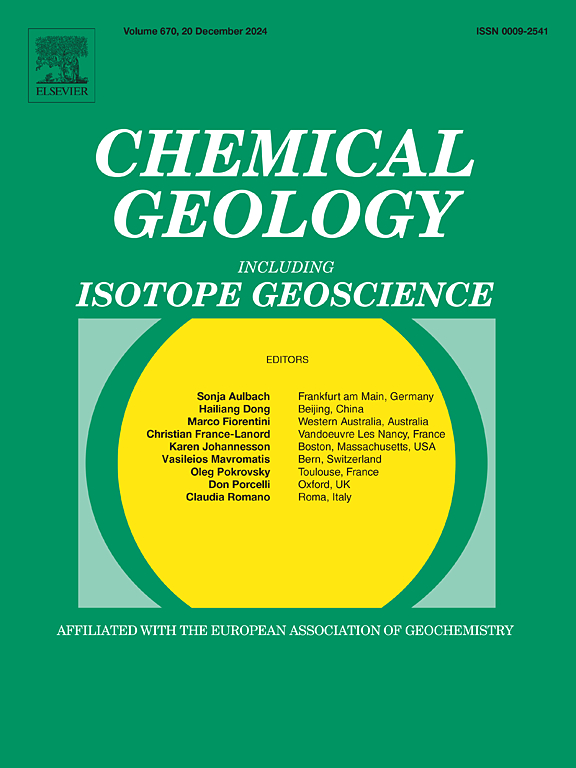2021年加那利群岛拉帕尔马Tajogaite火山喷发期间,每日OP-FTIR气体成分对岩浆动力学的洞察
IF 3.6
2区 地球科学
Q1 GEOCHEMISTRY & GEOPHYSICS
引用次数: 0
摘要
从2021年9月19日到12月12日,加那利群岛的拉帕尔马岛发生了一次混合型喷发,导致了Tajogaite火山锥的生长。从10月3日到火山喷发结束,每天的开放路径傅立叶变换红外(o - ftir)测量使我们能够捕捉到从新火山锥的顶部和侧面喷口喷出的岩浆气体中H2O, CO2, SO2, HCl和CO(偶尔加上COS)的摩尔比例。我们的研究结果显示,在火山喷发的大部分时间里,爆炸性气体排放中的CO2/SO2比率很高,范围从11到53,时间平均值为~ 30。相比之下,下侧翼喷口的射流脱气系统地显示CO2/SO2比降低(从3降至11),H2O、S和Cl的比例增加。结合溶解度数据和岩浆喷发速率,这一化学对比表明,在Tajogaite锥下的极浅管道分支中,气体分馏是大部分预溶的富co2气相,但有一小部分岩浆通过主喷发管道爆炸逸出,而耗尽co2的气体和大部分岩浆则通过侧分支喷涌排出。爆炸脱气的CO/COS/CO2比值(FMQ +1.7±0.3)与氧化岩浆条件的岩石学证据一致,增强了硫的溶解度和后期SO2的脱气。高氧化态和低HCl/HF比值是海洋岛玄武岩(OIB)岩浆活动的典型特征。在火山喷发的前半段,峰顶喷口的CO2/SO2和SO2/HCl比值明显增加,这与逐渐涌入的基性更强、更深层的玄武质岩浆相一致,尽管我们不能完全排除人工制品的可能性,因为在那个时期对纯爆炸性气体的测量更具挑战性。我们的研究首次提供了加那利群岛一次地面喷发期间气体地球化学的详细数据集,并强调了OP-FTIR光谱在火山喷发实时监测和研究方面的巨大潜力。本文章由计算机程序翻译,如有差异,请以英文原文为准。
Insights into magma dynamics from daily OP-FTIR gas compositions throughout the 2021 Tajogaite eruption, La Palma, Canary Islands
From September 19 to December 12, 2021, a mixed explosive-effusive eruption impacted La Palma Island, in the Canary archipelago, leading to the growth of Tajogaite volcanic cone. Daily Open-Path Fourier Transform Infrared (OP-FTIR) measurements from October 3 until the end of the eruption allowed us to capture the molar proportions of H2O, CO2, SO2, HCl and CO (plus COS occasionally) in magmatic gases emitted from summit and flank vents of the new cone. Our results reveal high CO2/SO2 ratios ranging from 11 to 53 in explosive gas emissions throughout most of the eruption, with a time-averaged value of ∼30. In contrast, effusive degassing at lower flank vents systematically displayed lower CO2/SO2 ratios (from 3 to 11) and enhanced proportions of H2O, S and Cl. Combined with solubility data and the magma eruption rates, this chemical contrast suggests gas fractionation in a very shallow conduit branching beneath the Tajogaite cone, were most of the pre-exsolved CO2-rich gas phase but a minor fraction of the magma explosively escaped through the main eruptive conduit, while CO2-depleted gas and most of the magma were effusively discharged through lateral branches. The CO/COS/CO2 ratios for explosive degassing are consistent with petrological evidence of oxidized magmatic conditions (FMQ +1.7 ± 0.3), which enhanced sulfur solubility and late-stage SO2 outgassing. The high oxidation state, as well as low HCl/HF ratios, retrieved from solar occultation across the volcanic plume, are both typical of Ocean Island Basalt (OIB) magmatism. The apparent increase of CO2/SO2 and SO2/HCl ratios at summit vents during the first half of the eruption is consistent with the influx of progressively more mafic, deeper-derived, basanitic magma, though we cannot entirely rule out artefacts due to more challenging measurement of the pure explosive gas in that period. Our study presents the very first detailed data set for gas geochemistry during a subaerial eruption in the Canary archipelago and highlights the remarkable potential of OP-FTIR spectroscopy for real-time monitoring and study of volcanic eruptions.
求助全文
通过发布文献求助,成功后即可免费获取论文全文。
去求助
来源期刊

Chemical Geology
地学-地球化学与地球物理
CiteScore
7.20
自引率
10.30%
发文量
374
审稿时长
3.6 months
期刊介绍:
Chemical Geology is an international journal that publishes original research papers on isotopic and elemental geochemistry, geochronology and cosmochemistry.
The Journal focuses on chemical processes in igneous, metamorphic, and sedimentary petrology, low- and high-temperature aqueous solutions, biogeochemistry, the environment and cosmochemistry.
Papers that are field, experimentally, or computationally based are appropriate if they are of broad international interest. The Journal generally does not publish papers that are primarily of regional or local interest, or which are primarily focused on remediation and applied geochemistry.
The Journal also welcomes innovative papers dealing with significant analytical advances that are of wide interest in the community and extend significantly beyond the scope of what would be included in the methods section of a standard research paper.
 求助内容:
求助内容: 应助结果提醒方式:
应助结果提醒方式:


